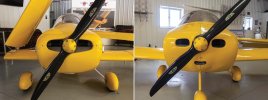Hey all, David Tibbo here. Amazing sleuthing you all do.
First, Dan's a great dude.
Second, I miss you Dan! Call me, seriously.
Third, here's the audio recording Dan is referencing. I couldn't figure out how to link it here, so I threw it up on youtube for now.

www.yout-ube.com
As an NFO, we were always told "In an emergency, you're not the pilot. The pilot is gonna save the day, not you. So the next best thing you can do is sound cool on the radio. Just sound like you're bored to tears, like that engine fire is the most uninteresting thing that's ever happened to you." So... I tried to sound bored and funny enough, it kept me calm. I was more annoyed than anything, because after three months of fiberglass work I was hoping to start flying every day. Despite Dan saying I was cool as a cucumber, I was still stressed enough to forget 7700 for emergency squawk.
It's a Sonex Waiex-B, and the engine is indeed a UL 260iS. The boxiness is simply because I suck at fiberglass. The first time I glassed the cowling, I was told I shouldn't "take that embarrassment near any airport", but the guy professionally restores antique cars. He wasn't wrong; it was ugly.
Anyways, first flight up in July 2020 and the oil over-temped. So, I replaced the relatively small oil cooler with one intended for a 6 cylinder engine. It's 50% larger than needed, and is moved a few inches further forward than minimums required. After that installation, I enlisted the help of three A&P students here at Purdue to assist in finishing the fiberglass. My goal was airworthy, not artful, and so we settled on the boxy shape you see. It's just the oil cooler. Oil temps were great (and super cold on my most recent glide down!)
As for what happened, I have hunches as to why I experienced low voltage (not complete power loss). I'm still looking into it. I'll be happy to update once I have definitive answers, but I'm not going to speculate further. Plenty are already doing fine on that front.
I never intended to land downtown. I truly believed I would make it to the airfield, and would not have attempted the glide otherwise. As for airmanship, thank you for the kind words. I'm just glad nobody was hurt. Prior to 2020, I haven't flow in nearly two years. I then went up twice in a Cessna last Spring 2020 to get my BFR current. I wasn't able to find a Sonex to do transition training (the factory no longer offers it, the nearest Sonex in Chicago was maintenance down). My first flight was on July 11, 2020. It was only 0.5 hours due to oil overtemp. Then with work and grad school and replacing the oil cooler, I was down for three months.
My second and third flights were the day before the off-airport landing, and were 0.8 and 0.5 hours, respectively. During those flights I determined slow flight characteristics and determined the clean stall speed of 37 knots. This fourth flight was intended to test flap operation and dirty stall speed. I didn't get around to lowering the flaps that flight.
So, yes, I've been flying since high school but my total hours are pretty low, only about 260 total. Time in the Sonex was 1.8 hours prior to the sudden drop-in at the movies. After I landed, a detective handed me a phone. It was Tower. They wanted to let me know it was free to land at the airport.


